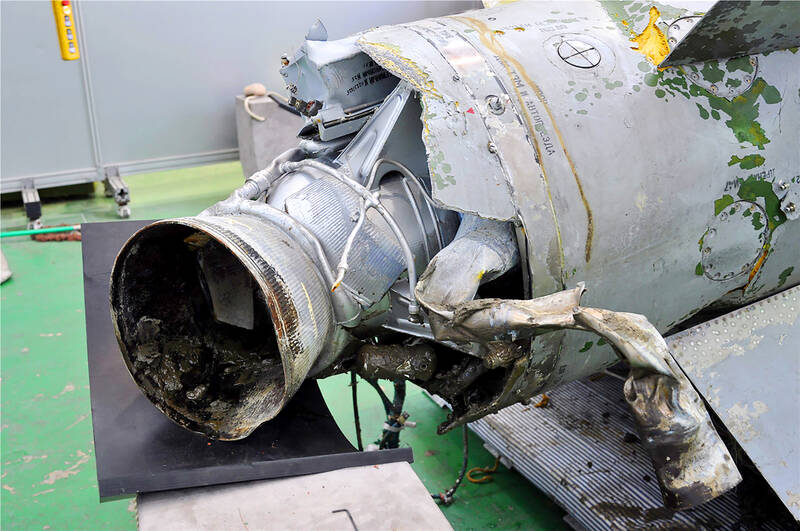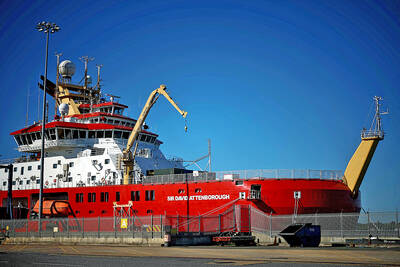North Korea yesterday fired a short-range ballistic missile toward its eastern sea, extending a recent barrage of weapons demonstrations, including what it described as simulated attacks on South Korean and US targets last week.
South Korea’s Joint Chiefs of Staff said the missile was launched from the western town of Sukchon, north of the capital, Pyongyang, and flew across the country toward waters off the North’s eastern coast.
The South Korean and Japanese militaries assessed that the missile flew about 250km to 290km at a maximum altitude of 30km to 50km. The relatively low trajectory seemed to align with the flight characteristics of some of North Korea’s newer short-range weapons designed to evade missile defenses.

Photo: AFP / South Korean Ministry of National Defense
Japanese Minister of Defense Yasukazu Hamada said the missile landed in waters outside of the country’s exclusive economic zone.
He said that North Korea’s intensifying testing activity was “significantly heightening” regional tensions and that Japan lodged a protest with the North through its embassies in Beijing.
The South Korean Ministry of Foreign Affairs said that its nuclear envoy, Kim Gunn, held separate telephone calls with his US and Japanese counterparts to discuss trilateral cooperation to counter North Korea’s increasing weapons tests and growing nuclear threat.
South Korean officials said the North could attempt to further raise pressure by conducting its first nuclear test since 2017 in the coming weeks.
The launch came after North Korea fired dozens of missiles last week in an angry reaction to a massive combined aerial exercise between the US and South Korea that the North described as an invasion rehearsal.
Earlier yesterday, South Korea’s military said the recovered debris of one of the North Korean missiles that flew southward last week was determined to be a Soviet-era anti-aircraft weapon that dates back to the 1960s.
The North’s military on Monday said that its launches last week were simulations to “mercilessly” strike key South Korean and US targets, such as air bases and operation command systems.
It said those tests included ballistic missiles loaded with dispersion warheads and underground infiltration warheads meant to launch strikes on enemy air bases, ground-to-air missiles designed to “annihilate” enemy aircraft at different altitudes and distances, and strategic cruise missiles that fell off South Korea’s southeastern coast.
The North described those launches as an appropriate response to the US and South Korea’s “Vigilant Storm” joint air force drills that wrapped up on Saturday, which involved about 240 warplanes, including B-1B supersonic bombers and advanced F-35 jets.
This week, the South Korean military has been conducting annual command post exercises meant to enhance crisis management and operational capabilities to cope with growing North Korean threats. The four-day training is to last until today.
The South Korean Ministry of National Defense yesterday said that an analysis of a 3m-long piece of wreckage fetched from waters near the Koreas’ eastern sea boundary on Sunday showed it was one of North Korea’s SA-5 surface-to-air missiles.
The ministry said a similar missile was used by the Russian military to execute ground attacks during its invasion of Ukraine.
Photographs released by the South Korean military show what appears to be a mangled rocket engine and wires sticking out from a broken rocket body that is still attached with fins.
The missile, which was one of more than 20 missiles North Korea fired on Wednesday last week, flew in the direction of a populated South Korean island and landed near the rivals’ tense sea border, triggering air raid sirens and forcing residents on Ulleung Island to evacuate.

STEPPING UP: Diminished US polar science presence mean opportunities for the UK and other countries, although China or Russia might also fill that gap, a researcher said The UK’s flagship polar research vessel is to head to Antarctica next week to help advance dozens of climate change-linked science projects, as Western nations spearhead studies there while the US withdraws. The RRS Sir David Attenborough, a state-of-the-art ship named after the renowned British naturalist, would aid research on everything from “hunting underwater tsunamis” to tracking glacier melt and whale populations. Operated by the British Antarctic Survey (BAS), the country’s polar research institute, the 15,000-tonne icebreaker — boasting a helipad, and various laboratories and gadgetry — is pivotal to the UK’s efforts to assess climate change’s impact there. “The saying goes

Floods on Sunday trapped people in vehicles and homes in Spain as torrential rain drenched the northeastern Catalonia region, a day after downpours unleashed travel chaos on the Mediterranean island of Ibiza. Local media shared videos of roaring torrents of brown water tearing through streets and submerging vehicles. National weather agency AEMET decreed the highest red alert in the province of Tarragona, warning of 180mm of rain in 12 hours in the Ebro River delta. Catalan fire service spokesman Oriol Corbella told reporters people had been caught by surprise, with people trapped “inside vehicles, in buildings, on ground floors.” Santa Barbara Mayor Josep Lluis

Police in China detained dozens of pastors of one of its largest underground churches over the weekend, a church spokesperson and relatives said, in the biggest crackdown on Christians since 2018. The detentions, which come amid renewed China-US tensions after Beijing dramatically expanded rare earth export controls last week, drew condemnation from US Secretary of State Marco Rubio, who on Sunday called for the immediate release of the pastors. Pastor Jin Mingri (金明日), founder of Zion Church, an unofficial “house church” not sanctioned by the Chinese government, was detained at his home in the southern city of Beihai on Friday evening, said

TICKING CLOCK: A path to a budget agreement was still possible, the president’s office said, as a debate on reversing an increase of the pension age carries on French President Emmanuel Macron yesterday was racing to find a new prime minister within a two-day deadline after the resignation of outgoing French Prime Minister Sebastien Lecornu tipped the country deeper into political crisis. The presidency late on Wednesday said that Macron would name a new prime minister within 48 hours, indicating that the appointment would come by this evening at the latest. Lecornu told French television in an interview that he expected a new prime minister to be named — rather than early legislative elections or Macron’s resignation — to resolve the crisis. The developments were the latest twists in three tumultuous